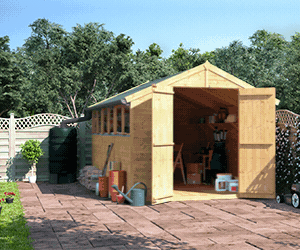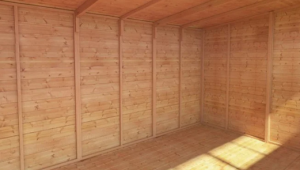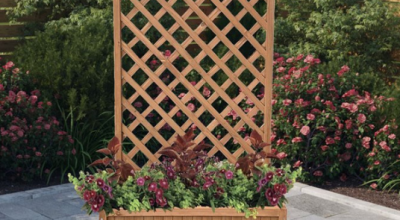Jump to:
Snow can be both enchanting and challenging for plants – unless you’ve got a BillyOh greenhouse for them. As winter blankets your garden in white, you need to take action. But what to do?
In this guide, we’ll delve into the nuances of snow and its impact on different plant types. Read on and discover proactive measures to prepare your garden for the snowfall!
Understanding Snow and Plants

Snowfall affects various plants differently. Understanding these impacts is crucial for effective care. Broadleaf evergreens, such as rhododendrons and hollies, are particularly vulnerable. The weight of snow can strain their branches, leading to breakage. Similarly, deciduous trees may face damage, especially young or brittle ones. Perennials, when not properly insulated, can succumb to the freezing temperatures. This, in turn, can cause damage to their roots.
Common challenges during snowfall include decreased sunlight absorption, which limits photosynthesis. The accumulation of snow on branches may disrupt the natural structure of plants, too. By recognising these, you can tailor your plant care methods to mitigate such risks.
Preparing Your Garden for Snow

(Image Credit: Wikimedia Commons)
As winter approaches, plants may or may not withstand the challenges of snowfall. To guarantee their safety, proactive measures are key. Begin by clearing debris and removing dead plants. Doing so minimises potential hiding spots for pests and diseases. Mulching is also a crucial step to insulate the soil. This technique can provide a protective barrier against freezing temperatures. Adding a layer helps regulate soil temperature, reducing stress on the plant roots.
Additionally, consider protecting vulnerable plants with covers or blankets. Frost cloths, for one, are breathable fabrics designed to shield plants. Burlap wraps also provide insulation against cold and wind. These makeshift shields act as a barrier against frost, wind, and heavy snow. Their addition can help in reducing the risk of damage to delicate foliage.
By implementing these steps, you fortify your garden against the harsh elements. You set the stage for resilient and thriving plants even in the midst of winter.
Snow-Specific Plant Care Tips

Adapting your care routines becomes essential to support the needs of different plants. The key here is to categorise your greens and tailor care practices accordingly. That way, you can ensure each thrives in its unique winter environment. Below are some general plant care tips for reference:
Adjusting watering routines
Different plant types have distinct water requirements. Dormant perennials, such as peonies or daylilies, need minimal watering during winter. Meanwhile, evergreens like junipers and pines thrive when the soil is consistently moist. Such conditions provide them with the necessary hydration to endure winter stress.
Maintain a delicate balance, as overwatering can be detrimental, leading to root rot. This is particularly relevant for plants that prefer well-draining soil, such as lavender.
Tip: Regularly assess soil moisture levels and adjust your watering practices accordingly.
Pruning strategies for snowy conditions
Prepare your trees for winter by implementing strategic pruning techniques. Before the first snowfall, focus on deciduous trees like maples or oaks. Prune away any weak, dead, or damaged branches to prevent breakage under the added load of snow. This approach safeguards the tree’s structure and promotes healthier growth for spring.
Light pruning is also key for maintaining the well-being of evergreens such as spruce or fir. Remove excess growth and shape the tree to reduce the surface area where snow can accumulate. This not only prevents potential damage but also helps the tree maintain its appeal.
Tailor your pruning to each plant type, making your garden more resilient, even in the snow.
Emergency Measures for Snow Damage
When snow wreaks havoc on your plants, consider these measures to minimise impact:
- Dealing with broken branches and limbs: After a heavy snowfall, assess your garden. Look for any broken branches and prune damaged sections promptly if there are any. This will help prevent further harm and encourage healthy regrowth. This is especially crucial for trees like birch, which are prone to snow-induced breakage.
- Reviving frozen or damaged plants: Gently remove snow and ice to expose them to warmer air. Gradually add water to moisten the soil, creating a nurturing environment for recovery. This approach is particularly beneficial for cold-sensitive plants like hydrangeas or succulents.
- Mitigating immediate issues: Get rid of heavy snow from plant surfaces for anti-breakage. Shake the snow off branches and gently brush off leaves to alleviate stress. These measures can make a significant difference for plants like arborvitae or boxwood.
Winterising Your Garden
Prepare your garden for the winter chill with these steps for long-term resilience:
Long-term strategies for plant resilience
Implement measures to fortify your garden against winter challenges. Mulching, proper soil preparation, and strategic plant placement contribute to overall resilience. Consider the specific needs of each plant type, adapting your care routines accordingly.
Choose cold-resistant plant varieties
Opt for plants that thrive in colder climates. This will enhance your garden’s ability to withstand winter conditions. Examples include winterberry holly, coneflowers, or ornamental grasses. These varieties not can endure the cold and add visual interest to your winter landscape.
Create a snow-ready garden design
Design your garden with snow in mind. Plan for paths that are easy to shovel, and strategically place snow-resistant plants. Additionally, investing in a garden greenhouse provides extra protection for sensitive plants. Such structures can ensure a thriving garden throughout the winter months.
Round-up
By following these tips, your garden can thrive in winter. Apply these practices and enjoy a flourishing garden under the snowy blanket. Happy gardening!
Greenhouses prove invaluable in snowy weather. At BillyOh, we offer a great variety, featuring wooden greenhouses and metal greenhouses. Explore them today!
Up next on your reading list: How to Clear Snow from Your Driveway and Garden













What do you think ?